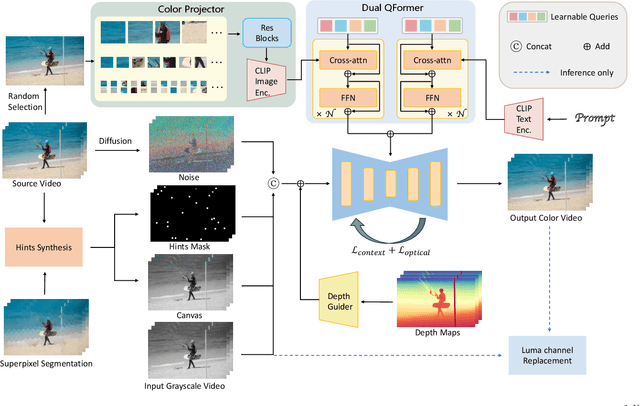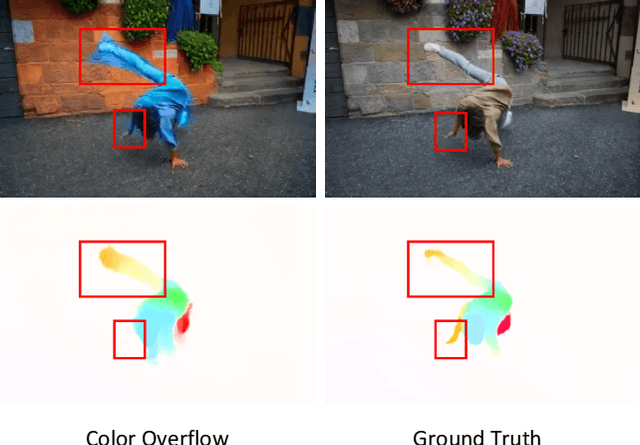Wei Zhai
University of Science and Technology of China, China, JD Explore Academy, JD.com, China
AliTok: Towards Sequence Modeling Alignment between Tokenizer and Autoregressive Model
Jun 05, 2025Abstract:Autoregressive image generation aims to predict the next token based on previous ones. However, existing image tokenizers encode tokens with bidirectional dependencies during the compression process, which hinders the effective modeling by autoregressive models. In this paper, we propose a novel Aligned Tokenizer (AliTok), which utilizes a causal decoder to establish unidirectional dependencies among encoded tokens, thereby aligning the token modeling approach between the tokenizer and autoregressive model. Furthermore, by incorporating prefix tokens and employing two-stage tokenizer training to enhance reconstruction consistency, AliTok achieves great reconstruction performance while being generation-friendly. On ImageNet-256 benchmark, using a standard decoder-only autoregressive model as the generator with only 177M parameters, AliTok achieves a gFID score of 1.50 and an IS of 305.9. When the parameter count is increased to 662M, AliTok achieves a gFID score of 1.35, surpassing the state-of-the-art diffusion method with 10x faster sampling speed. The code and weights are available at https://github.com/ali-vilab/alitok.
GRACE: Estimating Geometry-level 3D Human-Scene Contact from 2D Images
May 10, 2025Abstract:Estimating the geometry level of human-scene contact aims to ground specific contact surface points at 3D human geometries, which provides a spatial prior and bridges the interaction between human and scene, supporting applications such as human behavior analysis, embodied AI, and AR/VR. To complete the task, existing approaches predominantly rely on parametric human models (e.g., SMPL), which establish correspondences between images and contact regions through fixed SMPL vertex sequences. This actually completes the mapping from image features to an ordered sequence. However, this approach lacks consideration of geometry, limiting its generalizability in distinct human geometries. In this paper, we introduce GRACE (Geometry-level Reasoning for 3D Human-scene Contact Estimation), a new paradigm for 3D human contact estimation. GRACE incorporates a point cloud encoder-decoder architecture along with a hierarchical feature extraction and fusion module, enabling the effective integration of 3D human geometric structures with 2D interaction semantics derived from images. Guided by visual cues, GRACE establishes an implicit mapping from geometric features to the vertex space of the 3D human mesh, thereby achieving accurate modeling of contact regions. This design ensures high prediction accuracy and endows the framework with strong generalization capability across diverse human geometries. Extensive experiments on multiple benchmark datasets demonstrate that GRACE achieves state-of-the-art performance in contact estimation, with additional results further validating its robust generalization to unstructured human point clouds.
Event-Based Eye Tracking. 2025 Event-based Vision Workshop
Apr 25, 2025Abstract:This survey serves as a review for the 2025 Event-Based Eye Tracking Challenge organized as part of the 2025 CVPR event-based vision workshop. This challenge focuses on the task of predicting the pupil center by processing event camera recorded eye movement. We review and summarize the innovative methods from teams rank the top in the challenge to advance future event-based eye tracking research. In each method, accuracy, model size, and number of operations are reported. In this survey, we also discuss event-based eye tracking from the perspective of hardware design.
Event Signal Filtering via Probability Flux Estimation
Apr 10, 2025Abstract:Events offer a novel paradigm for capturing scene dynamics via asynchronous sensing, but their inherent randomness often leads to degraded signal quality. Event signal filtering is thus essential for enhancing fidelity by reducing this internal randomness and ensuring consistent outputs across diverse acquisition conditions. Unlike traditional time series that rely on fixed temporal sampling to capture steady-state behaviors, events encode transient dynamics through polarity and event intervals, making signal modeling significantly more complex. To address this, the theoretical foundation of event generation is revisited through the lens of diffusion processes. The state and process information within events is modeled as continuous probability flux at threshold boundaries of the underlying irradiance diffusion. Building on this insight, a generative, online filtering framework called Event Density Flow Filter (EDFilter) is introduced. EDFilter estimates event correlation by reconstructing the continuous probability flux from discrete events using nonparametric kernel smoothing, and then resamples filtered events from this flux. To optimize fidelity over time, spatial and temporal kernels are employed in a time-varying optimization framework. A fast recursive solver with O(1) complexity is proposed, leveraging state-space models and lookup tables for efficient likelihood computation. Furthermore, a new real-world benchmark Rotary Event Dataset (RED) is released, offering microsecond-level ground truth irradiance for full-reference event filtering evaluation. Extensive experiments validate EDFilter's performance across tasks like event filtering, super-resolution, and direct event-based blob tracking. Significant gains in downstream applications such as SLAM and video reconstruction underscore its robustness and effectiveness.
SIGMAN:Scaling 3D Human Gaussian Generation with Millions of Assets
Apr 09, 2025Abstract:3D human digitization has long been a highly pursued yet challenging task. Existing methods aim to generate high-quality 3D digital humans from single or multiple views, but remain primarily constrained by current paradigms and the scarcity of 3D human assets. Specifically, recent approaches fall into several paradigms: optimization-based and feed-forward (both single-view regression and multi-view generation with reconstruction). However, they are limited by slow speed, low quality, cascade reasoning, and ambiguity in mapping low-dimensional planes to high-dimensional space due to occlusion and invisibility, respectively. Furthermore, existing 3D human assets remain small-scale, insufficient for large-scale training. To address these challenges, we propose a latent space generation paradigm for 3D human digitization, which involves compressing multi-view images into Gaussians via a UV-structured VAE, along with DiT-based conditional generation, we transform the ill-posed low-to-high-dimensional mapping problem into a learnable distribution shift, which also supports end-to-end inference. In addition, we employ the multi-view optimization approach combined with synthetic data to construct the HGS-1M dataset, which contains $1$ million 3D Gaussian assets to support the large-scale training. Experimental results demonstrate that our paradigm, powered by large-scale training, produces high-quality 3D human Gaussians with intricate textures, facial details, and loose clothing deformation.
VideoGen-Eval: Agent-based System for Video Generation Evaluation
Mar 30, 2025



Abstract:The rapid advancement of video generation has rendered existing evaluation systems inadequate for assessing state-of-the-art models, primarily due to simple prompts that cannot showcase the model's capabilities, fixed evaluation operators struggling with Out-of-Distribution (OOD) cases, and misalignment between computed metrics and human preferences. To bridge the gap, we propose VideoGen-Eval, an agent evaluation system that integrates LLM-based content structuring, MLLM-based content judgment, and patch tools designed for temporal-dense dimensions, to achieve a dynamic, flexible, and expandable video generation evaluation. Additionally, we introduce a video generation benchmark to evaluate existing cutting-edge models and verify the effectiveness of our evaluation system. It comprises 700 structured, content-rich prompts (both T2V and I2V) and over 12,000 videos generated by 20+ models, among them, 8 cutting-edge models are selected as quantitative evaluation for the agent and human. Extensive experiments validate that our proposed agent-based evaluation system demonstrates strong alignment with human preferences and reliably completes the evaluation, as well as the diversity and richness of the benchmark.
EMoTive: Event-guided Trajectory Modeling for 3D Motion Estimation
Mar 17, 2025Abstract:Visual 3D motion estimation aims to infer the motion of 2D pixels in 3D space based on visual cues. The key challenge arises from depth variation induced spatio-temporal motion inconsistencies, disrupting the assumptions of local spatial or temporal motion smoothness in previous motion estimation frameworks. In contrast, event cameras offer new possibilities for 3D motion estimation through continuous adaptive pixel-level responses to scene changes. This paper presents EMoTive, a novel event-based framework that models spatio-temporal trajectories via event-guided non-uniform parametric curves, effectively characterizing locally heterogeneous spatio-temporal motion. Specifically, we first introduce Event Kymograph - an event projection method that leverages a continuous temporal projection kernel and decouples spatial observations to encode fine-grained temporal evolution explicitly. For motion representation, we introduce a density-aware adaptation mechanism to fuse spatial and temporal features under event guidance, coupled with a non-uniform rational curve parameterization framework to adaptively model heterogeneous trajectories. The final 3D motion estimation is achieved through multi-temporal sampling of parametric trajectories, yielding optical flow and depth motion fields. To facilitate evaluation, we introduce CarlaEvent3D, a multi-dynamic synthetic dataset for comprehensive validation. Extensive experiments on both this dataset and a real-world benchmark demonstrate the effectiveness of the proposed method.
HERO: Human Reaction Generation from Videos
Mar 11, 2025Abstract:Human reaction generation represents a significant research domain for interactive AI, as humans constantly interact with their surroundings. Previous works focus mainly on synthesizing the reactive motion given a human motion sequence. This paradigm limits interaction categories to human-human interactions and ignores emotions that may influence reaction generation. In this work, we propose to generate 3D human reactions from RGB videos, which involves a wider range of interaction categories and naturally provides information about expressions that may reflect the subject's emotions. To cope with this task, we present HERO, a simple yet powerful framework for Human rEaction geneRation from videOs. HERO considers both global and frame-level local representations of the video to extract the interaction intention, and then uses the extracted interaction intention to guide the synthesis of the reaction. Besides, local visual representations are continuously injected into the model to maximize the exploitation of the dynamic properties inherent in videos. Furthermore, the ViMo dataset containing paired Video-Motion data is collected to support the task. In addition to human-human interactions, these video-motion pairs also cover animal-human interactions and scene-human interactions. Extensive experiments demonstrate the superiority of our methodology. The code and dataset will be publicly available at https://jackyu6.github.io/HERO.
VanGogh: A Unified Multimodal Diffusion-based Framework for Video Colorization
Jan 16, 2025



Abstract:Video colorization aims to transform grayscale videos into vivid color representations while maintaining temporal consistency and structural integrity. Existing video colorization methods often suffer from color bleeding and lack comprehensive control, particularly under complex motion or diverse semantic cues. To this end, we introduce VanGogh, a unified multimodal diffusion-based framework for video colorization. VanGogh tackles these challenges using a Dual Qformer to align and fuse features from multiple modalities, complemented by a depth-guided generation process and an optical flow loss, which help reduce color overflow. Additionally, a color injection strategy and luma channel replacement are implemented to improve generalization and mitigate flickering artifacts. Thanks to this design, users can exercise both global and local control over the generation process, resulting in higher-quality colorized videos. Extensive qualitative and quantitative evaluations, and user studies, demonstrate that VanGogh achieves superior temporal consistency and color fidelity.Project page: https://becauseimbatman0.github.io/VanGogh.
Deep Learning-Based Feature Fusion for Emotion Analysis and Suicide Risk Differentiation in Chinese Psychological Support Hotlines
Jan 15, 2025



Abstract:Mental health is a critical global public health issue, and psychological support hotlines play a pivotal role in providing mental health assistance and identifying suicide risks at an early stage. However, the emotional expressions conveyed during these calls remain underexplored in current research. This study introduces a method that combines pitch acoustic features with deep learning-based features to analyze and understand emotions expressed during hotline interactions. Using data from China's largest psychological support hotline, our method achieved an F1-score of 79.13% for negative binary emotion classification.Additionally, the proposed approach was validated on an open dataset for multi-class emotion classification,where it demonstrated better performance compared to the state-of-the-art methods. To explore its clinical relevance, we applied the model to analysis the frequency of negative emotions and the rate of emotional change in the conversation, comparing 46 subjects with suicidal behavior to those without. While the suicidal group exhibited more frequent emotional changes than the non-suicidal group, the difference was not statistically significant.Importantly, our findings suggest that emotional fluctuation intensity and frequency could serve as novel features for psychological assessment scales and suicide risk prediction.The proposed method provides valuable insights into emotional dynamics and has the potential to advance early intervention and improve suicide prevention strategies through integration with clinical tools and assessments The source code is publicly available at https://github.com/Sco-field/Speechemotionrecognition/tree/main.
 Add to Chrome
Add to Chrome Add to Firefox
Add to Firefox Add to Edge
Add to Edge